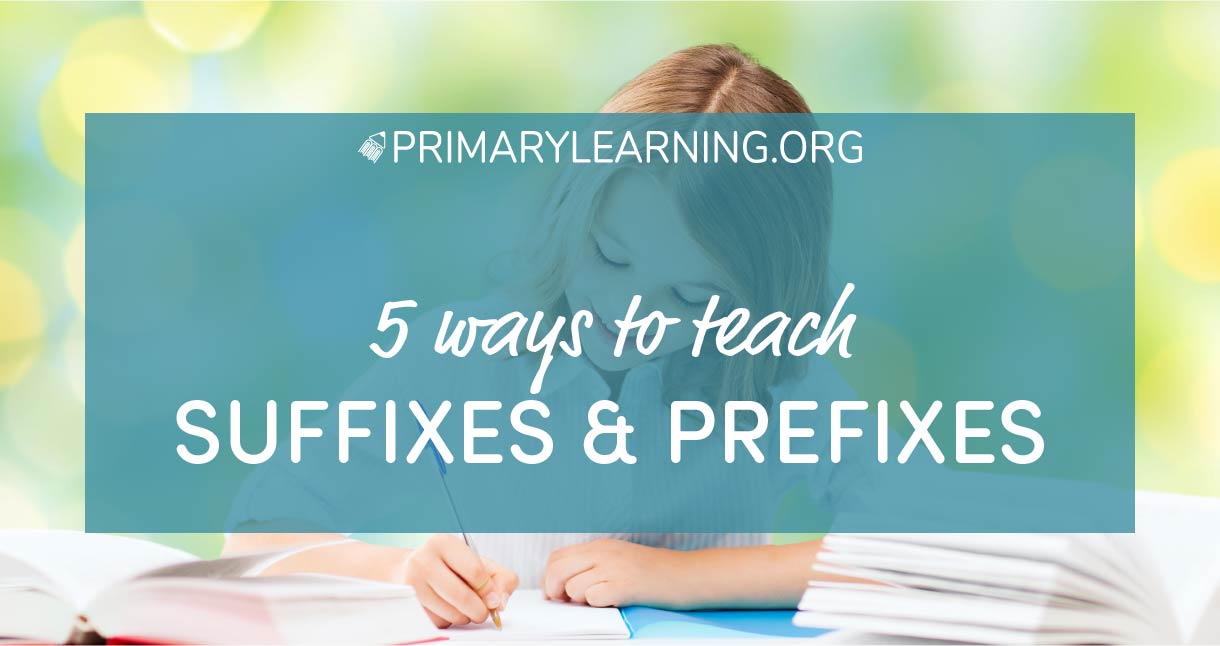

Posted by: Alesia Netuk
Updated: October 2nd, 2023
5 Ways to Teach Prefixes and Suffixes
5 Ways to Teach Prefixes and Suffixes
A student’s vocabulary quickly increases once he/she understands the meaning of prefixes and suffixes. Prefix: letters added to a word to form a new word that changes the meaning. There are more than 50 common prefixes in the English language, including dis-, ex-, in-, un-, post-, d, pre-, re-, and others. The two most common prefixes are “un” and “re.” Suffix: letters that are added after a word to change its meaning. More than 20 common suffixes in the English language, including -er and -or, -ful, -less, -ment, -ness, -y, and others. The most common suffixes in English are -ed, es-, -ing, and -ly.
Teaching by Analogy
Teaching by analogy allows the students to build upon what they already know. You may structure the lesson with a combination of prefixes, roots, and suffixes after introducing the word parts and definitions that comprise the lesson.
Then make it fun: in two minutes, ask the class to write all the words they know that use the prefix and suffix that have been provided. When the two minutes are up, the class can share the words they’ve written. As they list their words, write each word that uses the definition you gave them and define it.
Pre- might be a popular one: prehistoric for dinosaur fans (and who isn’t a dinosaur fan?); preseason for football fans; pre-owned for buying a used car, predict for guessing which team will win, etc. Have the students write down each of the words on your list to add them to their vocabulary.
Teaching Spelling
Adding prefixes and suffixes to the root word changes the meaning of the word. Students will learn that the spelling of the root changes with suffixes and how prefixes are attached to blend with the roots.
Spelling Rules
- The spelling of the root word doesn’t change.
- Double letters, as when “mis” is added to “spell” can happen.
- Just because letters can be a prefix doesn’t mean they’re always a prefix; “re” in realize is not a prefix.
Differentiation spelling instruction will demonstrate how grade-level spelling can enhance the development of an advanced vocabulary. During the spelling test, mix up the order of the orders as you read them to learn the words and not memorize them. After a student is finished with their test, he/she can write a sentence with the words on the spelling test.
Association
Memorizing common prefixes and suffixes strengthens a student’s memory while increasing familiarity with the words. Compile a list of words using the most common prefixes and suffixes.
Once the student has memorized the prefixes and suffixes, he/she will know how to understand other words using those same prefixes and suffixes.
Context Clues Writing
Detecting the meaning of an unfamiliar word by knowing the meaning of the prefix is a useful tool. Context clues such as synonyms and antonyms help to construct the meaning of the entire word.
If a student knows that “bi” means two, he/she can figure out that a bicycle is a cycle with two wheels. Students may develop their familiarity with the prefixes by identifying the meaning of the word parts.
Hyphens
- Add a hyphen to the root word in the following instances: When the prefix is added to a proper noun or a number; for example, pro-American or pre-2017;
- Ex, when meaning former, is joined to the root with a hyphen; ex-NFL star;
- The prefix “self” is joined to the root word with a hyphen, as in self-esteem;
- Hyphenate when the prefix combinations would be mispronounced: co-worker makes much more sense than coworker would;
- Hyphenate between the prefix and the root word when separating the letters “e” or “o”;
- Hyphenate when there is a possibility that the meaning of the word may be uncertain: you may recover from an illness, but you need to re-cover the motorcycle.
Studying prefixes and suffixes can be a fun way to increase vocabulary and promote an understanding of grammar. There are various ways to teach these lessons with games and activities that encourage learning in an enjoyable environment.
Printable worksheets:
I Want to be a Doctor | Prefix and Suffix Activities
Prefix and suffix activities for 3rd grade students. Students identify and understand how prefix and suffix influence the meaning of words.
Language Work | Prefix -DIS
This worksheet asks children to label stages of the butterfly life cycle in the correct spots. Children are encouraged to check their answers against the butterfly life cycle poster.
Language Work | Prefix -DIS
Language Work | Suffixes -LESS and -FUL
Students identify the suffixes ‘ly’ and understand how it influences the meaning of words. Encourage your students to discuss the importance of base words changed by suffixes.
Language Work | Suffix -LY
Students identify the prefix ‘dis’ and understand how it influences the meaning of words. Encourage your students to discuss the importance of base words changed by the prefix.
Language Work | Suffix -LY
LEARNING MATERIALS TO MEET EVERY CHILD’S NEEDS
Here, at PrimaryLearning.Org, we tend to deliver the best-differentiated learning materials to K-2 students. Our resources can be easily incorporated into multisensory lessons to meet every child’s needs, whether s/he is a visual, kinesthetic, or auditory learner.